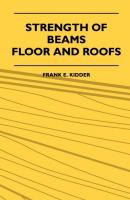Strength Of Beams, Floor And Roofs - Including Directions For Designing And Detailing Roof Trusses, With Criticism Of Various Forms Of Timber Construction. Frank E. Kidder
Чтение книги онлайн.

Читать онлайн книгу Strength Of Beams, Floor And Roofs - Including Directions For Designing And Detailing Roof Trusses, With Criticism Of Various Forms Of Timber Construction - Frank E. Kidder страница 6
To determine the maximum uniformly distributed load for a rectangular beam supported at both ends that will not produce a deflection exceeding 1-30 inch per foot of span.
Rule 17.—Multiply eight times the breadth by the cube of the depth, and the product by the value for E (Table II), and divide by five times the square of the span.
To determine the maximum center load for a rectangular beam supported at both ends that will not produce undue deflection.
Rule 18.—Multiply the breadth by the cube of the depth, and the product by the value for E, and divide by the square of the span.
To determine the SIZE OF BEAM to support a given distributed load without producing undue deflection, the beam being supported at both ends.
Rule 19.—Assume the depth. Multiply five times the load by the square of the span, and divide by eight times the cube of depth times E. The answer will be the breadth in inches.
To determine the SIZE OF BEAM to support a given center load without producing undue deflection, the beam being supported at both ends.
Rule 20.—Assume the depth. Multiply the load by the square of the span, and divide by the cube of the depth multiplied by E. The answer will be the breadth in inches.
Table II.—Value of E, to be Used in Rules 17-20.
| Kind of Wood. | E, in Pounds. |
| Chestnut | 72 |
| Hemlock | 80 |
| Oak, white | 95 |
| Pine, Georgia yellow | 137 |
| Pine, Norway | 100 |
| Pine, Oregon | 110 |
| Pine, Texas yellow | 120 |
| Pine, common white | 82 |
| Redwood | 60 |
| Spruce | 100 |
| Whitewood (poplar) | 95 |
Example XII.—What is the maximum distributed load that a 2 × 12 inch spruce beam, 16 feet span, will support without undue deflection?
Answer.—Apply Rule 17. Eight times the breadth times the cube of the depth times E = 8 × 2 × 1728 × 100 = 2,764,800. This divided by five times the square of the span or 1280 = 2160 pounds, the answer.
Example XIII.—A white pine floor joist of 18-foot span has to support a uniformly distributed load of 1440 pounds; what should be the size of the beam that the deflection may not be excessive?
Answer.—We will try 10 inches for the depth of the beam, and use Rule 19. Five times the load multiplied by the square of the span = 5 × 1440 × 324 = 2,332,800. Eight times the cube of the depth × E = 8 × 1000 × 82 = 656,000, and 2,332,800 ÷ 656,000 = 3 1/2 inches, the breadth.
If we use 12 inches for the depth we will have 2,332,800 ÷ 1,133,568, which gives 2 inches for the breadth, showing that a 2 × 12 joist of 18-foot span has the same stiffness as one 3 1/2 × 10 inches, although the latter beam contains nearly 50 per cent. more lumber than the former.
CONTINUOUS BEAMS.
A continuous beam is one which extends over three or more supports.
The formulas for determining the strength and stiffness of such beams are too elaborate to be reduced into simple rules, but it is worth while to know how the strength and stiffness of such beams compare with the strength and stiffness of a single span.
The strength of a continuous girder of two spans, Fig. 12, is the same as if the girder were cut over the support, when the load is distributed over the full length of the beam, but when the load is applied at the center of each span the strength of the beam is increased one-third by making it continuous over the center support, provided that the spans are equal. If the spans are unequal the increase in the strength will be less.
Fig. 12.—Continuous Girder of Two Spans.
Fig. 13.—Continuous Beam of Three Equal Spans.
The stiffness of a continuous beam of two equal spans is more than doubled by having the beam continuous over the center support, whether the load is distributed or concentrated.
In the case of a continuous beam of three equal spans, Fig. 13, the strength is increased one-fourth when the load is distributed, and two-thirds when equal loads are applied at the center of each span, and the stiffness is increased about 90 per cent. in both cases. It is therefore desirable to make beams continuous whenever practicable.
When beams are made continuous over three or more supports the points of greatest strain are those which come over the center supports or support, hence the beam should not be cut into at those points.
BEARING OF BEAMS ON THE WALL OR SUPPORT.
The transverse strength of a beam is not affected by the distance that the end of the beam extends onto the support, but the bearing must be sufficient that the beam will not pull off from the support when it is loaded, or that the bottom fibers of the beam will not be crushed by the load. This latter consideration is one which should be considered in the case of short beams loaded to their full capacity. Every wooden beam should have a bearing area—that is, the product of the breadth of the beam by the bearing, Fig. 1—equal to the load divided by 1000 for hard pine or oak, 500 for spruce and 400 for soft pine.
Thus a 10 × 12 inch white pine beam, of 8-foot span, might СКАЧАТЬ